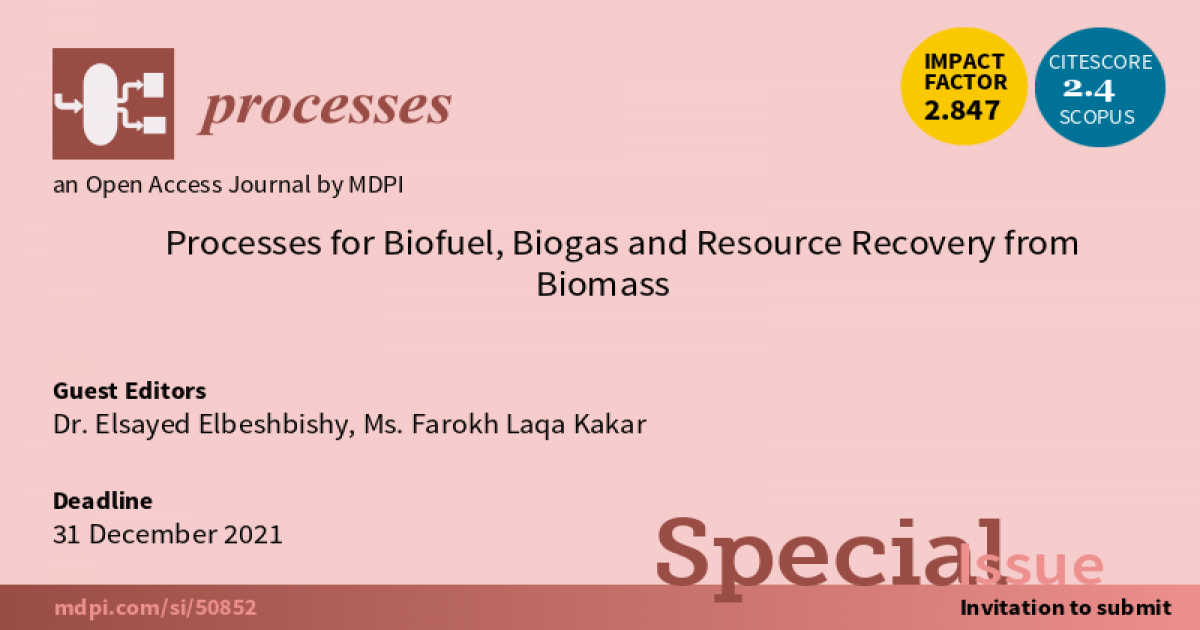- 2.8Impact Factor
- 5.5CiteScore
- 16 daysTime to First Decision
Processes for Biofuel, Biogas and Resource Recovery from Biomass
This special issue belongs to the section “Environmental and Green Processes“.
Special Issue Information
Dear Colleagues,
We would like to take this opportunity to invite you to participate in a Special Issue on “Processes for Biofuel, Biogas and Resource Recovery from Biomass”, to be published in Processes. Processes (ISSN 2227-9717; CODEN: PROCCO, 2019 Impact Factor: 2.753) is an international peer-reviewed open access journal on processes in chemistry, biochemistry, biology, materials, and related process/systems engineering research fields.
There is growing interest in biofuels in many developing countries as a means of “modernizing” biomass use and providing greater access to clean liquid fuels while helping to address energy costs, energy security, and global warming concerns associated with petroleum fuels. On the other hand, landfilling is a major global challenge, which results in environmental degradation and is not an absolute and environmentally friendly solution to waste management. Therefore, alternative processes to not only treat the waste but to produce value-added products has been considered. Further, there has been growing attention to the development of reliable technologies for conversion of biomass specially waste to biofuels and other value-added bioproducts and thereby building sustainable waste infrastructures while producing alternative energy to the fossil fuel. This Special Issue on “Processes for Biofuel, Biogas and Resource Recovery from Biomass” seeks high-quality works and topics focusing on the existing and emerging processes for biofuel, biogas, and value-added resource recovery from a variety of biomass such as waste, crops, and wood.
Potential topics include but are not limited to the following:
- Anaerobic digestion of organic waste;
- Transesterificationof oil and fat;
- Esterification of vegetable and animal oils;
- Partial combustion of biomass;
- Pyrolysis of biomass;
- Hydrocracking biological oils;
- Bio-electrochemical conversion of biowaste;
- Microbial fermentation for liquid and gaseous biofuels production;
- Waste-to-bioenergy;
- Thermochemical conversion of waste;
- Enzymatic conversion of waste.
Dr. Farokh Laqa Kakar
Guest Editors
Manuscript Submission Information
Manuscripts should be submitted online at www.mdpi.com by registering and logging in to this website. Once you are registered, click here to go to the submission form. Manuscripts can be submitted until the deadline. All submissions that pass pre-check are peer-reviewed. Accepted papers will be published continuously in the journal (as soon as accepted) and will be listed together on the special issue website. Research articles, review articles as well as short communications are invited. For planned papers, a title and short abstract (about 100 words) can be sent to the Editorial Office for announcement on this website.
Submitted manuscripts should not have been published previously, nor be under consideration for publication elsewhere (except conference proceedings papers). All manuscripts are thoroughly refereed through a single-blind peer-review process. A guide for authors and other relevant information for submission of manuscripts is available on the Instructions for Authors page. Processes is an international peer-reviewed open access monthly journal published by MDPI.
Please visit the Instructions for Authors page before submitting a manuscript. The Article Processing Charge (APC) for publication in this open access journal is 2400 CHF (Swiss Francs). Submitted papers should be well formatted and use good English. Authors may use MDPI's English editing service prior to publication or during author revisions.
Keywords
- Biofuel
- Biomass
- Anaerobic digestion
- Fermentation
- Transesterification
- Pyrolysis
- Combustion
- Esterification
- Bio-electrochemical processes
- Thermochemical conversion
- Enzymatic conversion

Benefits of Publishing in a Special Issue
- Ease of navigation: Grouping papers by topic helps scholars navigate broad scope journals more efficiently.
- Greater discoverability: Special Issues support the reach and impact of scientific research. Articles in Special Issues are more discoverable and cited more frequently.
- Expansion of research network: Special Issues facilitate connections among authors, fostering scientific collaborations.
- External promotion: Articles in Special Issues are often promoted through the journal's social media, increasing their visibility.
- e-Book format: Special Issues with more than 10 articles can be published as dedicated e-books, ensuring wide and rapid dissemination.

